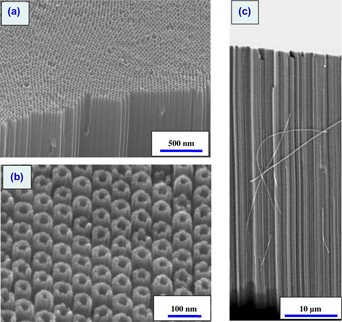Crossref Citations
This article has been cited by the following publications. This list is generated based on data provided by
Crossref.
NOH, KUNBAE
BRAMMER, KARLA S.
SEONG, TAE-YEON
and
JIN, SUNGHO
2011.
GUIDED NANOSTRUCTURES USING ANODIZED ALUMINUM OXIDE TEMPLATES.
Nano,
Vol. 06,
Issue. 06,
p.
541.
El-Sayed, Hany A.
Horwood, Corie A.
Abhayawardhana, Anusha D.
and
Birss, Viola I.
2013.
New insights into the initial stages of Ta oxide nanotube formation on polycrystalline Ta electrodes.
Nanoscale,
Vol. 5,
Issue. 4,
p.
1494.
Ni, Jiahua
Noh, Kunbae
Frandsen, Christine J.
Kong, Seong Deok
He, Guo
Tang, Tingting
and
Jin, Sungho
2013.
Preparation of near micrometer-sized TiO2 nanotube arrays by high voltage anodization.
Materials Science and Engineering: C,
Vol. 33,
Issue. 1,
p.
259.
Horwood, C.A.
El-Sayed, H.A.
and
Birss, V.I.
2014.
Precise electrochemical prediction of short tantalum oxide nanotube length.
Electrochimica Acta,
Vol. 132,
Issue. ,
p.
91.
Prida, V.M.
Vega, V.
García, J.
Iglesias, L.
Hernando, B.
and
Minguez-Bacho, I.
2015.
Magnetic Nano- and Microwires.
p.
3.
Choi, Duyoung
Kuru, Cihan
Choi, Chulmin
Noh, Kunbae
Hwang, Sookhyun
Choi, Wonbong
and
Jin, Sungho
2015.
Unusually High Optical Transparency in Hexagonal Nanopatterned Graphene with Enhanced Conductivity by Chemical Doping.
Small,
Vol. 11,
Issue. 26,
p.
3143.
Tripathy, Jagnyaseni
and
Wiley, John B.
2015.
Fabrication of thick porous anodized aluminum oxide templates.
Journal of Solid State Electrochemistry,
Vol. 19,
Issue. 5,
p.
1447.
Schimo, Gabriela
and
Hassel, Achim Walter
2016.
3D printed double flow cell for local through-thickness anodisation in aluminium.
Electrochemistry Communications,
Vol. 69,
Issue. ,
p.
84.
Staninski, Krzysztof
Piskuła, Zbigniew
and
Kaczmarek, Małgorzata
2017.
Photo- and electroluminescence properties of lanthanide tungstate-doped porous anodic aluminum oxide.
Optical Materials,
Vol. 64,
Issue. ,
p.
142.
Amouzadeh Tabrizi, Mahmoud
Ferre-Borrull, Josep
and
Marsal, Lluis F.
2020.
Advances in Optical Biosensors and Sensors Using Nanoporous Anodic Alumina.
Sensors,
Vol. 20,
Issue. 18,
p.
5068.
Wen, Tingting
Tan, Haoyan
Chen, Shan
He, Pengfei
Yang, Shuai
Deng, Chao
and
Liu, Shifeng
2021.
Growth behavior of tantalum oxide nanotubes during constant current anodization.
Electrochemistry Communications,
Vol. 128,
Issue. ,
p.
107073.
Cabral-Miramontes, José
Almeraya-Calderón, Facundo
López, Francisco Estupinán
Lara Banda, María
Olguín-Coca, Javier
López-León, Luis Daimir
Castañeda-Robles, Ivan
Alcalá, Miguel Ángel Esneider
Zambrano-Robledo, Patricia
and
Gaona-Tiburcio, Citlalli
2021.
Citric Acid as an Alternative to Sulfuric Acid for the Hard-Anodizing of AA6061.
Metals,
Vol. 11,
Issue. 11,
p.
1838.
Miramontes, José Cabral
Gaona Tiburcio, Citlalli
García Mata, Estefanía
Esneider Alcála, Miguel Ángel
Maldonado-Bandala, Erick
Lara-Banda, Maria
Nieves-Mendoza, Demetrio
Olguín-Coca, Javier
Zambrano-Robledo, Patricia
López-León, Luis Daimir
and
Almeraya Calderón, Facundo
2022.
Corrosion Resistance of Aluminum Alloy AA2024 with Hard Anodizing in Sulfuric Acid-Free Solution.
Materials,
Vol. 15,
Issue. 18,
p.
6401.
Kaviti, Ajay Kumar
and
Akkala, Siva Ram
2023.
Influence of anodization time on Al2O3 nanoporous morphology and optical properties using energy band gap at room temperature.
Results in Engineering,
Vol. 17,
Issue. ,
p.
100816.
Sarraf, Masoud
Razak, Bushroa Abdul
Musharavati, Farayi
Ibrahim, Mahmoud Z.
Hashemi, Ramin
and
Chowdhury, Muhammad E.H.
2023.
Structural, cell culture, antibacterial and in vitro bioactivity analysis of highly-ordered Al2O3 nanotube coating with decorated Ag2O nanoparticles on Ti-6Al-4V.
Surfaces and Interfaces,
Vol. 42,
Issue. ,
p.
103328.
Cabral-Miramontes, Jose
Cabral-Miramontes, Noe
Nieves-Mendoza, Demetrio
Lara-Banda, Maria
Maldonado-Bandala, Erick
Olguín-Coca, Javier
Lopez-Leon, Luis Daimir
Estupiñan-Lopez, Francisco
Calderon, F. Almeraya
and
Gaona Tiburcio, Citlalli
2024.
Anodizing of AA2024 Aluminum–Copper Alloy in Citric-Sulfuric Acid Solution: Effect of Current Density on Corrosion Resistance.
Coatings,
Vol. 14,
Issue. 7,
p.
816.
Kaviti, Ajay Kumar
Akkala, Siva Ram
Jeremias, Michal
Pohorely, Michael
and
Sikarwar, Vineet Singh
2024.
Submerged nanoporous anodized alumina structure for solar-powered desalination.
Environmental Science and Pollution Research,
Vol. 31,
Issue. 30,
p.
43186.
Cabral-Miramontes, José
Almeraya-Calderón, Facundo
Méndez-Ramírez, Ce Tochtli
Flores-De los Rios, Juan Pablo
Maldonado-Bandala, Erick
Baltazar-Zamora, Miguel Ángel
Nieves-Mendoza, Demetrio
Lara-Banda, María
Pedraza-Basulto, Gabriela
and
Gaona-Tiburcio, Citlalli
2024.
Effect of Citric Acid Hard Anodizing on the Mechanical Properties and Corrosion Resistance of Different Aluminum Alloys.
Materials,
Vol. 17,
Issue. 17,
p.
4285.



